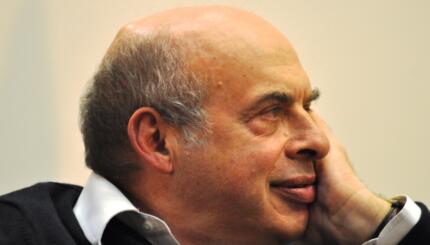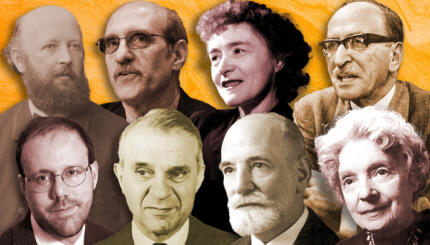In the United States, education in the traditions of Judaism has had a complex history, which has been dominated by numerous shifts in its orientation and goals. From the colonial period, when the small Sephardic community established its first private school, to the congregational schools established by the German-Jewish community in the mid-19th century, to the community-based Talmud Torah schools that served the Eastern European immigrants of the early 20th century, Jewish education has attempted to parallel and complement the American educational system and to create lasting institutions that preserve and sustain Jewish life as a vital force for the next generation.
Jewish education has been used both for Americanization and for preserving European Jewish culture and tradition. It has been the source of controversy and debate over the relationship between religious and secular education.
 The First American Jewish Schools
The First American Jewish Schools
The earliest Sephardic Jewish settlers in North America either educated their children privately in their own homes or paid for them to be taught in private schools. In the colonial era and throughout the early 19th century, education was not considered to be a Jewish communal responsibility.
The first official school under Jewish auspices was established at Shearith Israel (the Spanish and Portuguese Synagogue) in 1731 in New York City. Focusing on Hebrew studies, the school (although attached to the synagogue) operated as a separate entity with its own fees. In 1755, Shearith Israel expanded to include secular subjects, such as English composition. After closing during the Revolutionary War, the school reopened and functioned as a day school until 1821, receiving state funds as part of New York’s newly created common school system that enabled poor Jewish children to receive an education.
With your help, My Jewish Learning can provide endless opportunities for learning, connection and discovery.
Overall, few 18th-century congregations established lasting institutions. There was a general belief that Jewish education was part-time and secondary. Secular and religious studies were seen as separate activities.
Congregational Schools
In the mid-19th century, the new German Jewish immigrants — dissatisfied with the content and quality of Jewish studies — began to establish congregational day schools that combined secular and religious education. B’nai Jeshurun, New York City’s first Ashkenazic synagogue, became the first to organize a day school in 1842. A few years later, Isaac Mayer Wise [a luminary of the American Reform movement] founded the Talmud Yeladim Institute in Cincinnati and, in 1851, the Hebrew Educational Society was established in Philadelphia. Despite tremendous initial enthusiasm, these schools did not last beyond the Civil War era.
By the 1870s, the Jewish congregation day school movement had collapsed in disarray for a variety of reasons, including the lack of national coordination and the transient nature of the Jewish population. Also, state education systems began to satisfy the needs of many Jewish parents.
By the late 19th century a growing number of German Jews began to believe that Jewish day schools would create an unhealthy division between Jewish and gentile communities at a time when Central European immigrants and their children were themselves becoming part of the American mainstream. American culture and integrated schooling were embraced as a tool of socialization.
At the same time as Jews became more integrated into general, public education, synagogues began developing supplementary Jewish schooling for religious instruction. Rebecca Gratz established the first Sunday school in Philadelphia, and other synagogues began full-day Sabbath and afternoon programs. The influence of Reform Judaism, focusing on the universalism rather than the particularism of Judaism, meant that many of these synagogue programs eschewed Hebrew and the study of classical texts in favor of monotheism and English translations of the Bible. The first Hebrew free schools also emerged, in the post-Civil War era, as a means of providing Jewish education for the children of less affluent parents and to counteract the influence of the Christian mission schools in Jewish neighborhoods.
Talmud Torahs
The late 19th and early 20th centuries witnessed the arrival of hundreds of thousands of Eastern European immigrants who felt little or no connection to most of the Jewish education options available. They generally rejected the free schools and the universalism of the Reform supplementary programs, with some in New York City gravitating instead to the community-based Talmud Torah schools, which used their native Yiddish as the language of instruction and emphasized traditional learning of Torah and Talmud.
Not surprisingly, the, established German Jewish community viewed the Talmud Torah schools negatively because of their belief that sustaining the East European shtetl [village] traditions and religious practices represented a step backward from becoming full-fledged and culturally refined Americans.
Challenges: Public Schools vs. Jewish Schools
Although settled “American Jews” created educational institutions such as the Educational Alliance to transform immigrants and clashed with the newcomers over their desire to preserve old world ways, it did not take long for East European Jewish immigrants to accept the public schools for the education of their sons and daughters. The community cohesion necessary to create Jewish day schools that both offered religious studies and also satisfied new state education requirements proved daunting.
Despite the reverence for tradition on the part of new immigrant families, most parents wanted their children to learn the language and values of their new home. Although Eastern European Jewish men created heders (religious elementary schools) to replicate educational institutions similar to those in the old country, American-influenced sons did not necessarily share the enthusiasm of their fathers for the heder rav (leader) and the world he represented. By the beginning of World War I, only one-quarter of school-aged children received any Jewish education in New York City.
In significant decline, Jewish education required an infusion of modernization and new blood, and it came in the person of Samson Benderly. Benderly became professionally committed to Jewish education while studying medicine in Baltimore. In the second decade of the 20th century, he came to New York to develop and lead the new Bureau of Jewish Education. As its main goal, the Bureau sought to unite the city’s Jewish population by connecting traditional Jewish forms to contemporary American ideals. Benderly encouraged Jewish educators to view the process of Americanization as compatible with building a viable Jewish culture in the United States.
At the same time as Louis Brandeis began to frame Zionism as fundamentally aligned with American values, the founders of modern Jewish education used much of the same rhetoric to promote Jewish education as blending the best of American and traditional Jewish thought and practice.
Although the Bureau sought to build a Jewish “common” school, its limited financial resources shifted its focus to working with New York City’s Talmud Torahs to improve and invigorate their curricula. But the new proliferation of Jewish educators precipitated the establishment of Bureaus of Jewish Education in a variety of other cities between 1915 and 1938, including Minneapolis, Pittsburgh, Detroit, Buffalo, and Baltimore, and led to the founding of new Hebrew teachers colleges.
Eastern European Jewish tradition tended to favor education for boys far more than for girls, with a focus on bar mitzvah preparation and prayer recital taught by private tutors or in the exclusively male heder setting. By 1920, the Jewish education of girls became more accepted, and the seminaries for training teachers for the Hebrew schools enrolled an increasing number of female students. In addition, in the Yiddish secular schools that developed during the 1920s from Socialist and labor Zionist foundations, girls studied equally with boys. Most Jewish private day schools continued to be exclusively for boys. In the 1930s, Shulamith, the first day school for girls, opened in Brooklyn with a curriculum virtually identical to that of the day schools for boys.
Day Schools
Beginning in the late 1930s and accelerating during and especially after World War II, the development of new Jewish congregational schools led to a focus primarily on religious rather than cultural education. Congregational schools of different Jewish denominations were able to develop in new urban and especially suburban settings, but the Yiddish schools and the more radical and nationalist educational programs fared less well because of increasing economic mobility and the acculturation of the children of immigrants. With the establishment of the State of Israel, the nationalist message became institutionalized within all but the most traditional Orthodox Jewish congregational schools.
One of the most astounding changes in modern Jewish education has been the growth of private Jewish day schools, a phenomenon that harkens back to the colonial era and the mid-19th century. This movement evolved [in part] because of the immigration of ultra-Orthodox Hasidic refugees arriving from Europe before and after World War II. With no desire to integrate themselves into the American mainstream or to separate general from religious instruction, these Hasidim developed separate schools for boys and girls to prepare them to become observant, ultra-Orthodox Jews.
More surprising, perhaps, has been the development by the Conservative movement of its own Solomon Schechter Day Schools, which have been established in more than 60 communities. The Reform movement has begun to develop day schools, although they represent only [a small percentage] of the overall total of these programs. The proliferation of these schools can be traced to the belief among many Jewish families born and educated in America that it is no longer necessary to send their children to public school to acculturate them as Americans. These parents want a Jewish educational system for their children because they want to imbue them with Jewish thought and values.
Reprinted with permission from the American Jewish Desk Reference (The Philip Lief Group).
UPDATE: Since this article was published, the situation in Schechter schools has changed, with many facing enrollment challenges, changing affiliation or closing altogether. To learn more about current trends in Orthodox and non-Orthodox Jewish day schools, congregational schools and Hebrew charter schools — consult our partner site JTA.
bar mitzvah
Pronounced: bar MITZ-vuh, also bar meetz-VAH, Origin: Hebrew, Jewish rite of passage for a 13-year-old boy.
Hasidic
Pronounced: khah-SID-ik, Origin: Hebrew, a stream within ultra-Orthodox Judaism that grew out of an 18th-century mystical revival movement.
mitzvah
Pronounced: MITZ-vuh or meetz-VAH, Origin: Hebrew, commandment, also used to mean good deed.
Sephardic
Pronounced: seh-FAR-dik, Origin: Hebrew, describing Jews descending from the Jews of Spain.
Talmud
Pronounced: TALL-mud, Origin: Hebrew, the set of teachings and commentaries on the Torah that form the basis for Jewish law. Comprised of the Mishnah and the Gemara, it contains the opinions of thousands of rabbis from different periods in Jewish history.
talmud torah
Pronounced: TALL-mud TORE-uh, Origin: Hebrew, old-fashioned name for Hebrew school.
Torah
Pronunced: TORE-uh, Origin: Hebrew, the Five Books of Moses.


